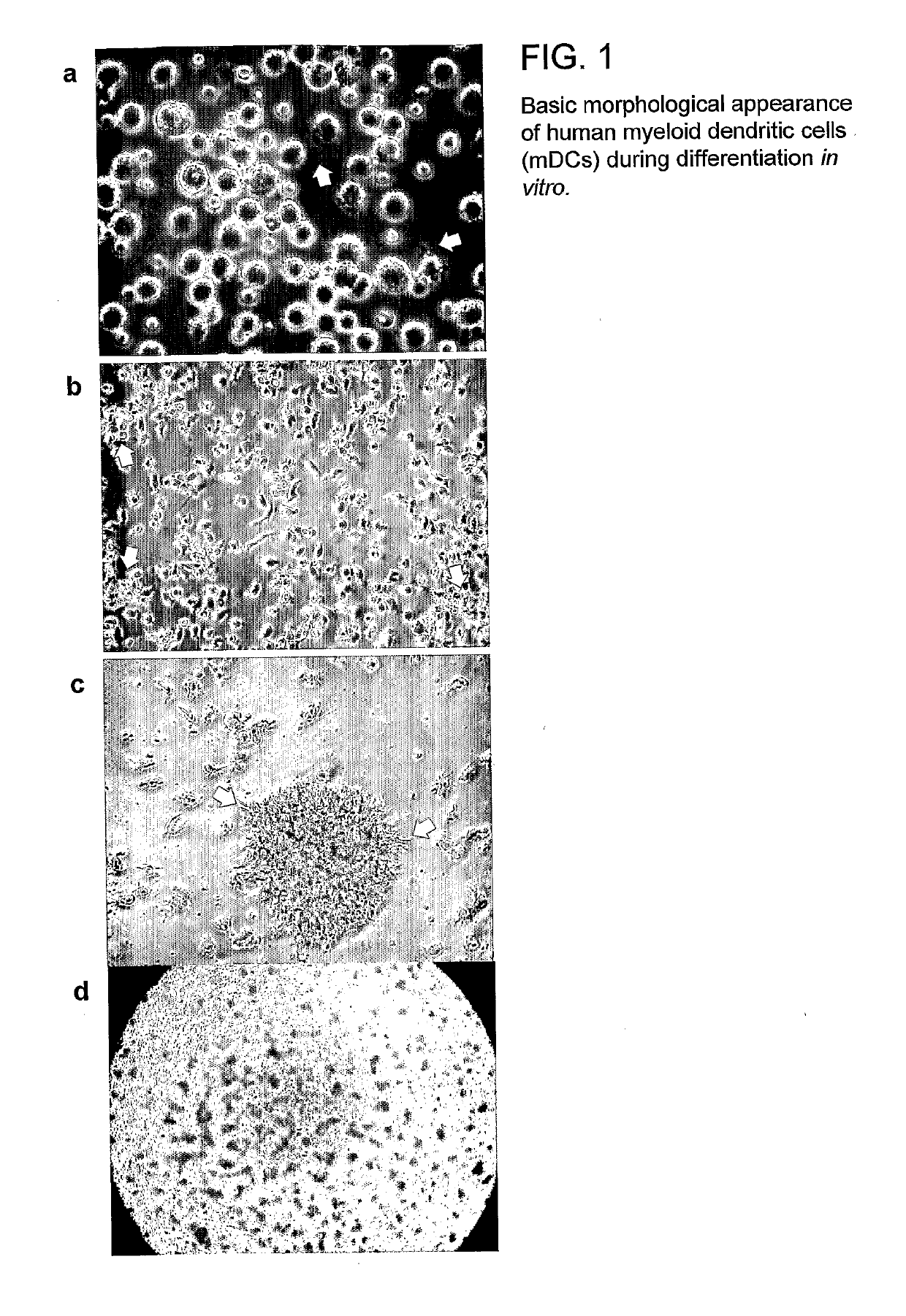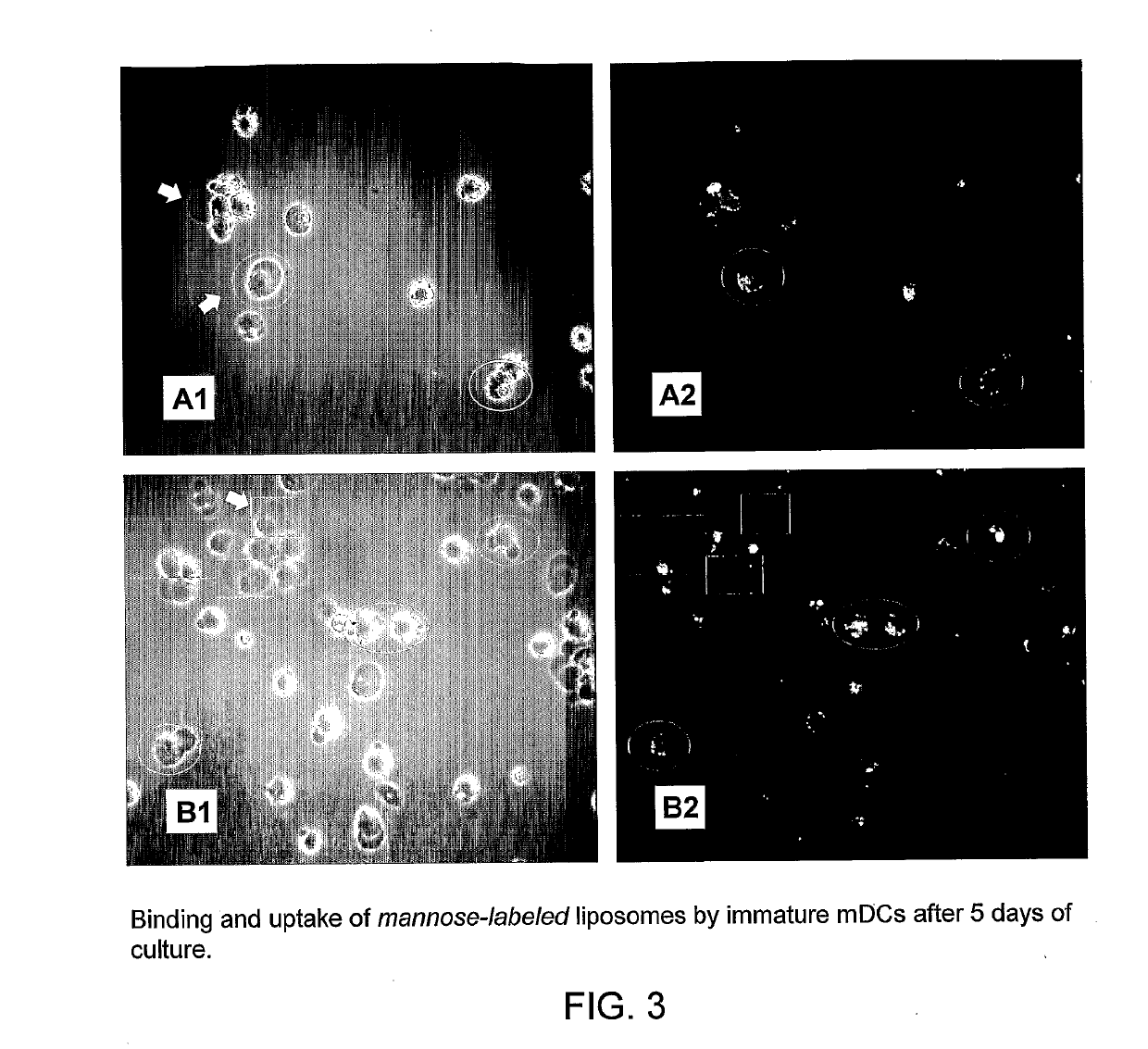Carbohydrate-Derivatized Liposomes for Targeting Cellular Carbohydrate Recognition Domains of Ctl/Ctld Lectins, and Intracellular Delivery of Therapeutically Active Compounds
a technology of carbohydrate recognition and liposome, which is applied in the field of medical science, can solve the problems of fat interference with actively propagating hiv and/or other viruses and bacteria, extremely low cost and toxicities, and achieves the effect of reducing the risk of infection
- Summary
- Abstract
- Description
- Claims
- Application Information
AI Technical Summary
Benefits of technology
Problems solved by technology
Method used
Image
Examples
example 1
and Methods
[0212]Preparation and Characterization of Liposomes.
[0213]Dioleoylphosphatidylcholine (DOPC) was purchased from Lipoid (Ludwigshafen, Germany) and cholesterol (Chol) was from Caelo (Caesar and Lorentz, Hilden, Germany). Sugar-cholesterol derivatives were synthesized as described below. Lipid-saccharide derivative mixtures (i.e. DOPC:Chol:Gal-C4-Chol, DOPC:Chol:Man-C4-Chol or DOPC:Chol:Gal-C4-Chol, each at 60:35:5 molar ratios; or DOPC:Chol as a negative control, at a 60:40 molar ratio) were dissolved in dichloromethane / methanol (1:2 v / v). The solvent was completely removed under reduced pressure at 35° C., followed by evaporation at high vacuum.
[0214]For fluorescence analyses, a solution of 50 mM calcein (Sigma, St. Louis, USA) and 1 mM EDTA (Merck, Darmstadt, Germany) was prepared and the pH was adjusted to 7.5 with NaOH. The dried lipid film was hydrated with 1 ml of the calcein solution by gentle mixing to yield a dispersion of approximately 30 mM total lipid. The disp...
example 2
ng of Myeloid Dendritic Cells
[0240]Peripheral blood mononuclear cells (PBMNCs) were evaluated according to their size (forward scatter) and granularity (side scatter) and thus were gated as naïve T and B cells; activated T-cells and B-cells; and monocytes, including a small proportion of blood dendritic cells (data not shown). Cultured monocyte-derived myeloid dendritic cells (mDCs or DCs) were tested for expression of markers delineating their developmental stage (maturity), as well as for mDC subtype markers. The DCs expressed markers typical for skin and mucosal DC phenotypes that are considered to play a key role in HIV infection. When being infected via the mucosal route, mucosal mDCs are the first immune cell type to be directly infected by HIV and (i) occasionally integrate its genetic information as proviral DNA and / or (ii) fixate HIV on their surface by DC-SIGN and / or (iii) take up HIV by any of various mechanisms to retain the virus in intracytoplasmic compartments (e.g., ...
example 3
rgeting of mDCs with Carbohydrate Surface-Labeled Liposomes: Fluorescence-Microscopic Uptake Studies, Flow-Cytometric Uptake and Binding Studies, and HIV Inhibition Studies
[0243]In initial control studies, cellular binding of Fuc-4C-Chol- as well as Man-4C-Chol-targeted liposomes was completely inhibited by adding 100 mM of free soluble L-fucose or D-mannose (positive control) to the cells before their incubation with liposomes. As expected, addition of D-galactose (negative control) was ineffective (all monosaccharides were purchased from Sigma, St. Louis, Mich., USA). These controls (results not shown) demonstrated that the fucose- and mannose-labeled liposomes specifically bound to the envisioned exocellular targeting structures, i.e. C-type lectin receptors.
[0244]A member of the CTL family, termed dendritic cell-specific intercellular adhesion molecule (ICAM)-3-grabbing nonintegrin (DC-SIGN; CD209), was targeted on immature and mature monocyte-derived dendritic cells at 37° C. H...
PUM
| Property | Measurement | Unit |
|---|---|---|
| size | aaaaa | aaaaa |
| size | aaaaa | aaaaa |
| size | aaaaa | aaaaa |
Abstract
Description
Claims
Application Information
 Login to View More
Login to View More - R&D
- Intellectual Property
- Life Sciences
- Materials
- Tech Scout
- Unparalleled Data Quality
- Higher Quality Content
- 60% Fewer Hallucinations
Browse by: Latest US Patents, China's latest patents, Technical Efficacy Thesaurus, Application Domain, Technology Topic, Popular Technical Reports.
© 2025 PatSnap. All rights reserved.Legal|Privacy policy|Modern Slavery Act Transparency Statement|Sitemap|About US| Contact US: help@patsnap.com



